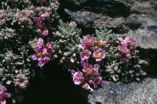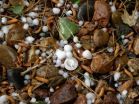(Press-News.org) GAINESVILLE, Fla. — A new University of Florida study shows genomes of a recently formed plant species to be highly unstable, a phenomenon that may have far-reaching evolutionary consequences.
Published online this week in the Proceedings of the National Academy of Sciences, the study is the first to document chromosomal variation in natural populations of a recently formed plant species following whole genome doubling, or polyploidy. Because many agricultural crops are young polyploids, the data may be used to develop plants with higher fertility and yields. Polyploid crops include wheat, corn, coffee, apples, broccoli and some rice species.
"It could be occurring in other polyploids, but this sort of methodology just hasn't been applied to many plant species," said study co-author Pam Soltis, distinguished professor and curator of molecular systematics and evolutionary genetics at the Florida Museum of Natural History on the UF campus. "So it may be that lots of polyploids – including our crops – may not be perfect additive combinations of the two parents, but instead have more chromosomes from one parent or the other."
Researchers analyzed about 70 Tragopogon miscellus plants, a species in the daisy family that originated in the northwestern U.S. about 80 years ago. The new species formed naturally when two plants introduced from Europe mated to produce a hybrid offspring, and hybridization was followed by polyploidy.
Using a technique called "chromosome painting" to observe the plants' DNA, UF postdoctoral researcher and lead author Michael Chester discovered that while whole genome doubling initially results in a new species containing 12 chromosomes from each parent, numbers subsequently vary among many plants.
The paints are made by attaching different dyes to DNA of the two parent species. Once the dye is applied, there is a match between the DNA of the paint and of the chromosome. Under a microscope, the chromosomes appear in one color or the other (red vs. green) depending on the parent from which they originated. Sometimes chromosomes are a patchwork of both colors because DNA from the two parents has been swapped as a result of chromosomal rearrangements.
"One of the things that makes this so amazing is that where we expected to see 12 chromosomes from each parent (the polyploid has 24 chromosomes), it turns out there aren't 12 and 12, there are 11 from one parent and 13 from the other, or 10 and 14," Soltis said. "We're hoping through some ongoing studies to be able to link these results with the occurrence of another interesting phenomenon – the loss of genes – and also see what effect these changes have on the way the plants grow and perform."
The polyploid's two parent species, Tragopogon dubius and Tragopogon pratensis, were introduced to the U.S. in the 1920s. Because its flower only blooms for a few hours in the morning, Tragopogon miscellus is often referred to as "John-go-to-bed-at-noon," and its common name is goatsbeard. It looks like a daisy except for being yellow in color.
"People have looked at these chromosomes before, but until you could apply these beautiful painting techniques, you couldn't tell which parent they each came from," Soltis said.
Of the six populations examined from Washington and Idaho, 69 percent of the plants showed a deviation from the expected 12 and 12 chromosome pattern.
"In order for most plants to be able to interbreed successfully, their chromosomes need to match up," Chester said. "That doesn't necessarily happen when you don't have equal numbers, so there may be some chromosomal barriers to fertility that develop as a result of this sort of chromosomal variation. This mechanism may also explain low fertility in other plants, such as crops. This is something we are looking into with Tragopogon."
The two-year study was funded by the National Science Foundation. Other co-authors include Doug Soltis, a distinguished professor in UF's biology department, UF undergraduate biology student Joseph Gallagher and Ana Veruska Cruz da Silva of Embrapa Tabuleiros Costeiros in Brazil and the Florida Museum.
"Among all of the processes that generate biological diversity in the plant kingdom, genome doubling, or polyploidy, is among the most prevalent and important," said Jonathan Wendel, professor and chairman of the department of ecology, evolution, and organismal biology at Iowa State University, in an email. "This is an area that is receiving international focus and research attention, but the system Pam and Doug Soltis are working on is unique."
###
Credits
Writer
Danielle Torrent, dtorrent@flmnh.ufl.edu
Source
Pam Soltis, psoltis@flmnh.ufl.edu, 352-273-1964
Source
Michael Chester, mchester@ufl.edu, 352-392-7924
Media Contact
Leeann Bright, lbright@flmnh.ufl.edu
END
Reston, Va. (December 28, 2011) – In a new review of imaging studies spanning more than ten years, scientists find that a method of positron emission tomography (PET) safely and accurately detects dementia, including the most common and devastating form among the elderly, Alzheimer's disease. This research is featured in the January issue of the Journal of Nuclear Medicine.
Researchers reviewed numerous PET studies to evaluate a molecular imaging technique that combines PET, which provides functional images of biological processes, with an injected biomarker called 18F-FDG ...
Insurance status doesn't affect the quantity (or value) of imaging services received by patients in a hospital, in-patient setting, according to a study in the January issue of the Journal of the American College of Radiology.
Approximately 51 million Americans, or 16.7 percent of the population, were without health insurance for some or all of 2009. Lack of insurance is associated with less preventive care, delays in diagnosis and unnecessary deaths.
"Americans without health insurance generally receive fewer health care services than those with insurance. Less ...
An article in the forthcoming issue of the Journal of Integrated Pest Management (JIPM) refutes claims by Greenpeace Germany that the western bean cutworm (WBC), Striacosta albicosta (Smith), is "a new plant pest" that was "caused by genetically engineered corn." The Greenpeace Germany report, which was written by author Christoph Then of Testbiotech, offers a "surprisingly simplistic conclusion" regarding the spread of western bean cutworm over the last decade, according to the JIPM authors.
In "Genetically Engineered Bt Corn and Range Expansion of the Western Bean Cutworm ...
A biology lab at Washington University has just cracked the structure and function of a protein that plays a key role in the life of a parasite that killed 655,000 people in 2010.
The protein is an enzyme that Plasmodium falciparum, the protozoan that causes the most lethal form of malaria, uses to make cell membrane.
The protozoan cannot survive without this enzyme, but even though the enzyme has many lookalikes in other organisms, people do not make it. Together these characteristics make the enzyme an ideal target for new antimalarial drugs.
The research was published ...
Climate change is having a more profound effect on alpine vegetation than at first anticipated, according to a study carried out by an international group of researchers and published in Nature Climate Change. The first ever pan-European study of changing mountain vegetation has found that some alpine meadows could disappear within the next few decades.
Led by researchers from the Austrian Academy of Sciences and the University of Vienna, biologists from 13 different countries in Europe analysed 867 vegetation samples from 60 different summits sited in all major European ...
We've all seen the story in the news before. Whether it's the death of a physically fit high school athlete at football training camp in August, or of an elderly woman gardening in the middle of the day in July, heat stroke is a serious, life-threatening condition for which there is no treatment beyond submersion in ice water or the application of ice packs to cool the body to a normal temperature.
But, in a new study published today in the journal Nature Medicine, scientists discovered what they believe is one of the first drugs to combat heat stroke. AICAR – an experimental ...
Summertime hail could all but disappear from the eastern flank of Colorado's Rocky Mountains by 2070, according to a new modeling study by scientists from NOAA and several other institutions.
Less hail damage could be good news for gardeners and farmers, said Kelly Mahoney, Ph.D., lead author of the study and a postdoctoral scientist at NOAA's Earth System Research Laboratory in Boulder, Colo. But a shift from hail to rain can also mean more runoff, which could raise the risk of flash floods, she said.
"In this region of elevated terrain, hail may lessen the risk of ...
A team of scientists, led by researchers at the University of California, San Diego School of Medicine and Zacharon Pharmaceuticals, have developed a simple, reliable test for identifying biomarkers for mucopolysaccharidoses (MPS), a group of inherited metabolic disorders that are currently diagnosed in patients only after symptoms have become serious and the damage possibly irreversible.
The findings will be published online January 8 in the journal Nature Chemical Biology.
MPS is caused by the absence or malfunctioning of a lysosomal enzyme required to break down ...
Much of what living cells do is carried out by "molecular machines" – physical complexes of specialized proteins working together to carry out some biological function. How the minute steps of evolution produced these constructions has long puzzled scientists, and provided a favorite target for creationists.
In a study published early online on Sunday, January 8, in Nature, a team of scientists from the University of Chicago and the University of Oregon demonstrate how just a few small, high-probability mutations increased the complexity of a molecular machine more than ...
CHAMPAIGN, Ill. — Those making land use decisions to reduce the harmful effects of climate change have focused almost exclusively on greenhouse gases – analyzing, for example, how much carbon dioxide is released when a forest is cleared to grow crops. A new study in Nature Climate Change aims to present a more complete picture – to incorporate other characteristics of ecosystems that also influence climate.
"We know that forests store a lot of carbon and clearing a forest releases carbon dioxide into the atmosphere and contributes to climate change," said University of ...



